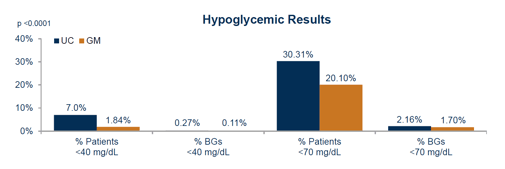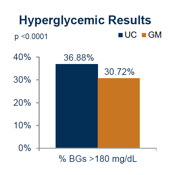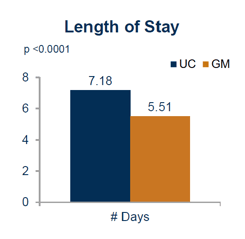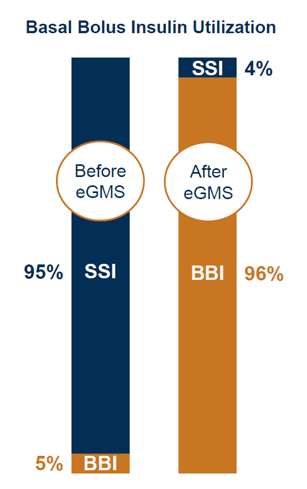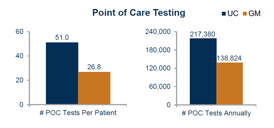Presentation
International Hospital Diabetes Meeting
Date
May 2017
Authors
Rosalina Newsom, Christopher Patty, Emma Camarena, Thomas Gray, Regina Sawyer, Brian Brown, Raymie McFarland
BACKGROUND
Hyperglycemia affects up to 40% of hospitalized patients and is associated with poor outcomes, including increased mortality, length of stay and surgical site infections. The standard of care is intravenous (IV) insulin therapy for critically ill patients and subcutaneous (SubQ) basal bolus insulin therapy (BBI) for non-critically ill patients. However, despite best practice guideline recommendations from AACE, ADA and other associations for use of BBI, use of sliding scale insulin therapy (SSI) persisted at our hospital because of familiarity, lack of diabetes and endocrinology expertise, and concerns over hypoglycemia. Glytec’s eGlycemic Management System® (eGMS®) was selected to facilitate the conversion from SSI to BBI.
METHODS
This retrospective quality improvement case study compared IV and SubQ insulin ‘usual care’ (UC) to that of the nurse-directed, computer-guided Glucommander (GM) solution, an FDA-cleared insulin dosing decision support module of eGMS that is integrated with our hospital’s electronic health record. Primary objectives of the study were to analyze utilization of BBI and to measure impact on glycemic outcomes, with a primary focus on hypoglycemic trends. Comparisons were made between pre-eGMS (baseline) data from calendar year 2015 and post-eGMS data from March 2016 through March 2017. Comparisons were also made between patients treated with UC and patients treated with GM during the first year of eGMS use in our hospital.
| PATIENT DEMOGRAPHICS | UC – Usual Care | GM – Glucommander |
|---|---|---|
| #Patients | 1,039 | 3,200 |
| Age | 61.91 | 63.32 |
| Gender – Male | 47% | 48% |
| Gender – Female | 53% | 52% |
| Height (cm) | 166.47 | 166.14 |
| Weight (kg) | 85.75 | 87.99 |
| BMI | 30.91 | 31.62 |
| LOS | 7.18 | 5.51 |
| A1c | 8.97 | 8.49 |
| GFR | 49.85 | 51.72 |
| Admission BG | 217.9 | 212.8 |
CLINICAL RESULTS
Upon implementing eGMS, our Medical Center converted to near-exclusive utilization of BBI in our inpatient population. Data over the first year showed that patients treated with GM spent more time in the target range of 70-180 mg/dL than patients treated with UC, with 2,434 fewer hypoglycemic events and 40,589 fewer hyperglycemic events. Additionally, patients treated with GM had a shorter LOS than patients treated with UC by 1.67 days.
- BBI Utilization: % patients prescribed a BBI regimen was 5% at baseline versus 96% after implementing eGMS.
- Severe Hypoglycemia <40 mg/dL: % patients was 7.0% for UC versus 1.84% for GM, a 73.7% reduction; % BGs was 0.27% for UC versus 0.11% for GM, a 59.2% reduction.
- Overall hypoglycemia <70 mg/dL: % patients was 30.31% for UC versus 20.1% for GM, a 33.7% reduction; % BGs was 2.16% for UC versus 1.7% for GM, a 21.3% reduction.
- Hyperglycemia >180 mg/dL: % BGs was 36.88% for UC versus 30.72% for GM, a 16.7% reduction.
- In-Target BGs 70-180 mg/dL: % BGs was 60.97% for UC versus 67.6% for GM, a 10.9% increase.
- Length of Stay: average # days was 7.18 for UC versus 5.51 for GM, a 23.1% reduction.
FINANCIAL RESULTS
Use of eGMS in our Medical Center resulted in substantial reductions in hypoglycemic events and point of care testing, which contributed to a total annualized savings of $7,489,420.
| Hypoglycemic Event Savings | $7,141,356 |
|---|---|
| POC Testing Savings | $348,064 |
| TOTAL Annualized Savings | $7,489,420 |
- Hypoglycemic Events: 2,434 fewer hypoglycemic events with GM versus UC, resulting in savings of $7,141,356 over the first year, or $2,934 per event.
- Point of Care Testing: 51.0 tests per patient with UC versus 26.8 with GM, a 47.4% reduction per patient, resulting in savings of $348,064 over the first year.
CONCLUSION
Glycemic management dramatically improved after the implementation of eGMS in our hospital. Use of eGMS, and the conversion from SSI to BBI, enhanced overall patient safety by reducing both hypoglycemia and hyperglycemia. The eGMS cost savings proved significant, producing a first year amount of $7,489,420.
